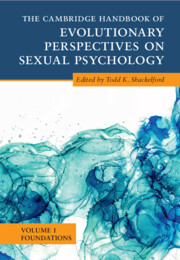Book contents
- The Cambridge Handbook of Evolutionary Perspectives on Sexual Psychology
- The Cambridge Handbook of Evolutionary Perspectives on Sexual Psychology
- Copyright page
- Contents
- Contributors
- Preface
- Part I Foundations of Evolution
- Part II Middle-Level Theories
- 7 Parental Investment Theory
- 8 Parent–Offspring Conflict
- 9 Theory and Evidence for Reciprocal Altruism
- 10 Life History Theory and Mating Strategies
- 11 Sperm Competition Theory
- 12 Sexual Conflict Theory
- 13 Cross-Species Comparisons
- 14 Cross-Cultural Methods in Sexual Psychology
- 15 Behavioral Genetics
- 16 Sex Differences and Sex Similarities
- 17 Individual Differences in Sexual Psychology
- 18 Experimental Methods in Sexual Psychology
- Index
- References
10 - Life History Theory and Mating Strategies
from Part II - Middle-Level Theories
Published online by Cambridge University Press: 30 June 2022
- The Cambridge Handbook of Evolutionary Perspectives on Sexual Psychology
- The Cambridge Handbook of Evolutionary Perspectives on Sexual Psychology
- Copyright page
- Contents
- Contributors
- Preface
- Part I Foundations of Evolution
- Part II Middle-Level Theories
- 7 Parental Investment Theory
- 8 Parent–Offspring Conflict
- 9 Theory and Evidence for Reciprocal Altruism
- 10 Life History Theory and Mating Strategies
- 11 Sperm Competition Theory
- 12 Sexual Conflict Theory
- 13 Cross-Species Comparisons
- 14 Cross-Cultural Methods in Sexual Psychology
- 15 Behavioral Genetics
- 16 Sex Differences and Sex Similarities
- 17 Individual Differences in Sexual Psychology
- 18 Experimental Methods in Sexual Psychology
- Index
- References
Summary
This chapter provides a theoretical and empirical framework for understanding the relation between life history strategy and mating strategies. The current scientific debate regarding the structure of life history and its connection to mating behaviors inspired the authors of this chapter to conduct several theoretical and empirical examinations of this subject. For example, phylogenetic confirmatory factor analysis across a sample of 503 eutherian mammals supports the presence of a higher-order life history factor comprised of lower-order factors that have been labeled fast–slow and neoteny, respectively. Consistent with past publications, the present chapter also found evidence supporting the predicted relation between life history indicators with mating strategies. Also consistent with previously published findings, one set of phylogenetic generalized linear models identified that polygynandrous mating systems in nonhuman primates, along with the [lactation/(lactation + gestation)] ratio, positively predicted infanticide by males. These constructive replications, however, also revealed the novel finding that the higher-order life history factor did not predict these infanticides when statistically controlled for the effects of the lower-order indicators. Hence, the specific variance associated with the lower-order indicators eliminates any significant residual contribution made by the higher-order life history factor. These results are not unexpected given the principle of Brunswik symmetry, wherein to attain optimal predictive power the predictor and criterion variable must be measured at the same level of data aggregation. These findings led us to conduct a theoretical examination of the psychometrically expected relations between higher-order factors, such as life history strategy, and lower-order factors, such as mating strategies, in general. We therefore explore the characteristics of the latent hierarchical structure of life history strategy that has been found in numerous empirical studies for the purpose of deriving more specific predictions regarding the effects of general life history strategy on specific mating strategies. We afterwards test the principle of Brunswik symmetry by reporting additional analyses of the expected moderating effect of slow life history strategy on the relation between short-term and long-term mating orientations, r(STM,LTM), in humans. A sequential canonical analysis revealed that the positive effect of slow life history strategy on r(STM,LTM) was fully mediated by a general strategic differentiation-integration factor (SD-IE) on life history traits. Individuals with slower life history strategies exhibited greater integration between short-term and long-term mating strategies. Consequently, this analysis counters a long-held position regarding any fixed association between slow life history strategy and the relationship between short-term and long-term mating orientations.
Keywords
- Type
- Chapter
- Information
- Publisher: Cambridge University PressPrint publication year: 2022
References
- 1
- Cited by

